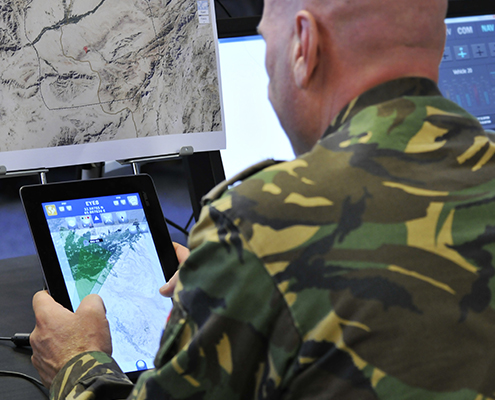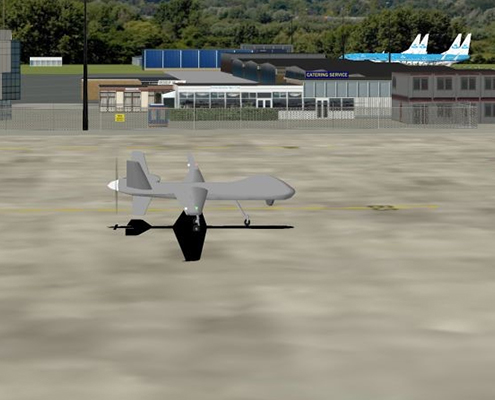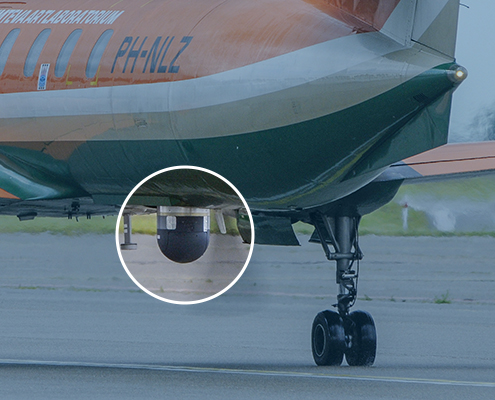A reconfigurable research facility for Unmanned Aerial Systems
NLR’s MUST facility is a research simulator that is intentionally kept generic and reconfigurable, so it can be deployed in a wide range of research areas. The facility comprises the simulation of aerial vehicles and their payloads, the environment (wind, other entities, etc), the datalink ánd the ground control station (GCS).
Broad range of research and training applications
Thanks to its flexible and reconfigurable nature, MUST can be used for a wide range of research areas. MUST can for example be used in combination with NLR’s air traffic control simulator NARSIM to investigate all kinds of questions and issues regarding integration in controlled airspace.
With NLR’s experience and knowledge of Artificial Intelligence (AI) and autonomy, opportunities to increase efficiency and performance (which might improve the so-called operator-to-vehicle ratio) can be investigated. In combination with other (military) flight simulators (of NLR) Manned-Unmanned Teaming (MUMT) aspects can be safely tested and investigated.
GCS’s of unmanned platforms are still mainly approached from a pilot perspective with traditional displays and controls, but new interaction concepts could be game changers in efficiency and performance. These new concepts can easily be tested with the adjustable HMI’s of MUST.
Next to the mentioned human-in-the-loop research MUST can also be used to test and evaluate hardware by hardware-in-the-loop assessments.
Besides the mentioned research area’s more use cases are conceivable.
Unique features
- Simulate multiple vehicles simultaneously, all controlled by one GCS
- Flight models can vary from small quadcopters to MALE/HALE fixed wing platforms
- Reconfigurable GCS: from a tablet interface to a dual operator station, with large touch screens and partial hands-on-stick-and-throttle (HOTAS) input concept
- Reconfigurable Human Machine Interfaces (HMI)
- STANAG 4586: control of both virtual- and operational compatible vehicles
Showcases
MUMT in SOF operation
MUST was deployed in a MUMT human-in-the-loop experiment. MUST provided other members of a military mission pack with sensor imagery on tablet devices. Special forces were able to control the unmanned platforms and their cameras from the ground to enhance their Situational Awareness (SA).
Airspace integration
NLR has partnered with General Atomics Aeronautical Systems Inc. (GA-ASI) and General Atomics United Kingdom (GA-UK) to gather the data needed to develop MALE RPAS airspace integration procedures through a series of Real-Time Simulation (RTS) experiments. For these experiments MUST and NARSIM are connected.
CONOPS
To try out the partaking of unmanned vehicles in a military mission, MUST was deployed in a joint military exercise. MUST’s GCS was data linked with one of NLR’s research aircrafts equipped with a EO/IR sensor. The position of the aircraft and the imagery of the sensor were made available to the mission commanders in the operation centre.
Specifications
The vehicle- and payload models are run using the simulation tool Eurosim (http://www.eurosim.nl/).
Different types of payload are modelled:
- Fixed nose-camera
- Gimballed EO/IR camera
- SAR sensor (under development)
- Detect and avoid sensors:
– Radar
– TCAS
– ADSB
The heart of the GCS is the Mission Module which acts as a server for an endless number of client HMIs. The HMIs are created with the use of Unity3D and are able to display videostreams, handle (HOTAS) inputs, load (3D) map layers, etc.
Different vehicle & payload control modes are supported, like auto-pilot control, missionplan-following, autolaunch and -land, slewing, georef-mode, tracking (under development) etc.
With the use of Computer Generated Forces (CGF)- tools scenarios can be created for human-in-the-loop experiments.
Interoperability
Based on the STANAG 4586* the software architecture of MUST is highly flexible in connecting to different types of platforms, multiple GCSs (for handover procedures) and Command, Control, Communication, Computer & Intelligence (C4I) systems.
MUST can be used in distributed simulations, both with other NLR simulation facilities (like NARSIM, F4S and NLR’s battlelab Cerebro).
Currently a STANAG 4609* videostream output is being developed which can be send to external systems like data analyse stations (for example NLR’s VES).
*NLR assists in standard development & implementation such as STANAG4586, -4545, -4817 and -4609





